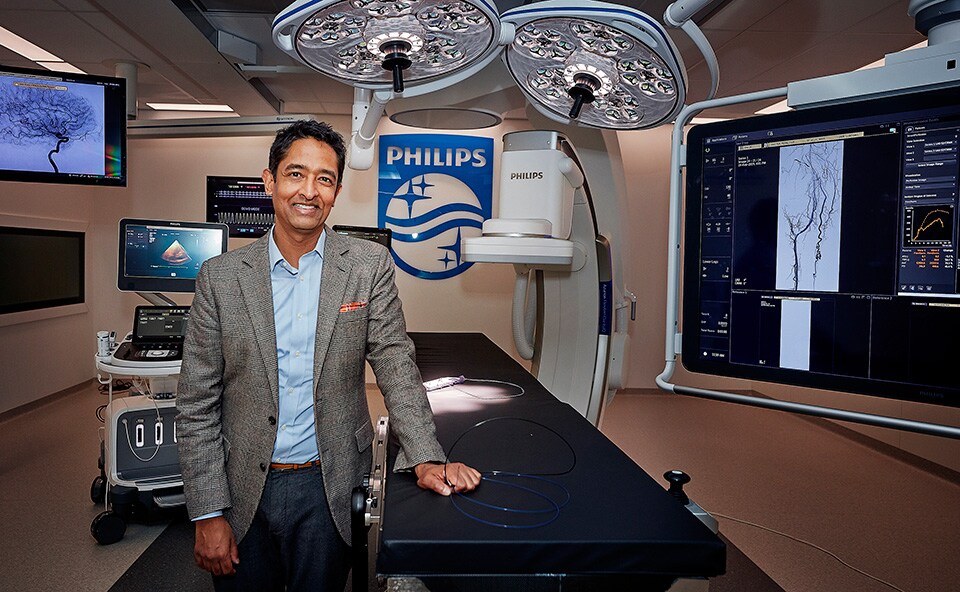By Bert Bukman, Zorgvisie Magazine. Original article was published in Dutch by Zorgvisie and can be found in Zorgvisie magazine and online https://www.zorgvisie.nl/philips-cmo-ik-zal-altijd-dokter-blijven/
Interventional radiologist Atul Gupta is Chief Medical Officer Image-Guided Therapy at Philips. He specializes in minimally-invasive treatment.
It all started one day in 1994, in an operating room in the New York hospital where Atul Gupta studied medicine. He would eventually become a surgeon, he was the youngest in his class because he was able to skip two years of college. Becoming a cardiac surgeon had always been his plan, but what he saw in that operating room radically changed the course of his career. The patient on the operating table was undergoing a new type of treatment. His liver was being operated on, with some of its blood vessels being re-connected artificially. It was a procedure that normally required major surgical intervention. However, on this patient it was being done differently. He was being operated on via a thin wire that entered through his neck. There was no question of cutting him open. A stent to support the re-connection was slipped over the wire, somewhat like a spaghetti string, and pushed forward until it reached the correct point in the patient’s liver. "I thought to myself: this is the future of healthcare. This is the way it has to go," says Atul at the Philips Innovation Center in Best, The Netherlands, where he has just given a presentation on minimally-invasive therapy – the clinical name for this type of intervention. "No longer an invasive procedure that it sometimes takes weeks for the patient to recover from, but a procedure performed from outside. To me it's still amazing. " 25 years have passed since that day in New York. For two decades, Atul worked as an interventional radiologist in Philadelphia, where he saw the technique of minimally-invasive therapy continue to improve. In addition, of course, to all the other technical changes that made his work as a clinician easier. "I was trained at a time when you viewed X-rays on a light box. You can hardly imagine that now, with all the possibilities that computer imaging offers. And when I started as a clinician, I recorded my diagnoses on a voice recorder, and then it was transcribed by a typist. The data now appears directly in the patient’s electronic medical record. So huge progress." But the biggest change for Atul is still the level of technological innovation in the field of image-guided therapy. "You can place more and more at the tip of that string – a laser, sensors, ultrasound equipment, a balloon or a small gripping arm. In short, everything I need for diagnosis or treatment. On my screens, I can now follow things much more accurately than I would ever have seen it with the naked eye." The result: the patient is treated faster and better. "He or she sometimes leaves the hospital the same day, with a bandage on a small wound instead of a huge scar from surgery. That’s a whole new ballgame compared to having to stay in hospital for days and rehabilitating for weeks, not to mention the costs for society."
I used to help one patient at a time, now I can help millions of people
Atul Gupta
Specialist in image-guided therapy at Philips
Four years ago, Atul’s career took a new turn. For some time he had been working closely with Philips, the company that made the equipment he used to perform his interventions, but now he switched to the laboratories of the medical technology company. Nowadays he works in a completely different way to perfect minimally-invasive techniques. "Instead of being able to change the life of one patient at a time, which I did as a clinician, I now have the opportunity to assist millions and maybe even billions of people around the world by improving the quality of their lives. I think that's great. Nevertheless, I will always remain a clinician. I still treat patients in the hospital a few days a month." Atul’s most important goal, as befits a Chief Medical Officer, is achieving an optimal connection with practice in the workplace. He believes that one of the most important elements is ease of use. "An operating room is a very busy place. There are sometimes seven or eight people around the operating table and there is much that demands the attention of the clinician. If he or she does not have equipment that is extremely intuitive to use, it will not be used. As a designer, you sometimes regret that, but that's how it works. You have to take it into account.” According to Atul, much can be learned from consumer electronics. "The ease of use of many consumer products is optimal. An iPhone is very easy to operate, and so is a PlayStation. I can talk to my car and it will immediately do what I say. That’s where we have to go in healthcare. Of course, the safety requirements are stricter - errors are actually not allowed - so we need more time. But that is the direction." Another perspective on the future is offered by the cooperation between Philips and Microsoft in the HoloLens 2 project. This involves the development of a holographic representation of the dashboard on which the clinician is shown all the treatment information. Atul shows a futuristic video, in which clinicians see all the necessary data in 3D. What he shows would not look out of place in a science fiction series. "We are proud that Microsoft has chosen us as a medical development partner in a very interesting project. Thanks to the HoloLens I can continue to focus on patients and at the same time see real-time data and 3D images of an organ or blood vessels to help me with my work. The system recognizes what I am doing with my hands and where I’m looking, then adapts to it. In addition, I can operate the system via spoken commands. That way I can focus even better on the patient."

All in all, Atul is satisfied with his transition from clinical practice to industry. "Philips has it all, the imaging technology, the medical equipment, and the software that connects it all together. This has always been an innovative company, a company of inventors, where I feel very much at home. We have calculated that thanks to our technology one patient per second is helped worldwide. That's why I do it. At the same time, I would not want to miss out on the medical practice, which is why I remain a clinician. I still treat patients three or four days a month. I will not give that up easily. So I combine it and have the best of both worlds. The only thing is that it costs me a few hours sleep every now and then."
Share on social media
Topics
Contact

Mark Groves
Philips Global Press Office Tel.: +31 631 639 916
You are about to visit a Philips global content page
Continue












